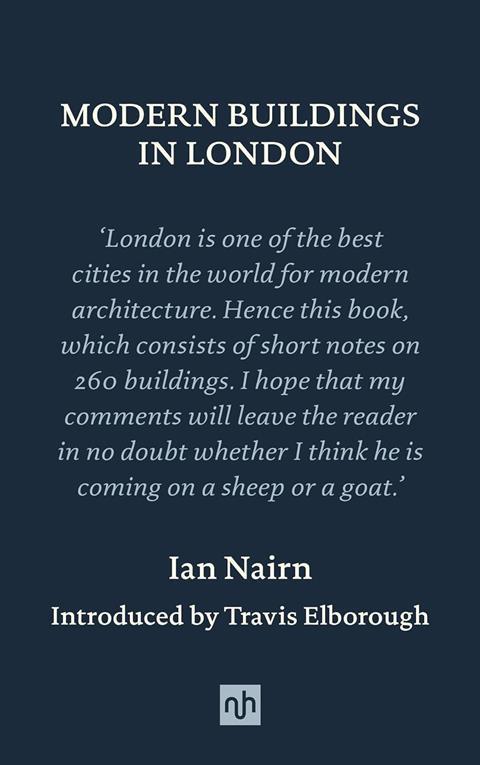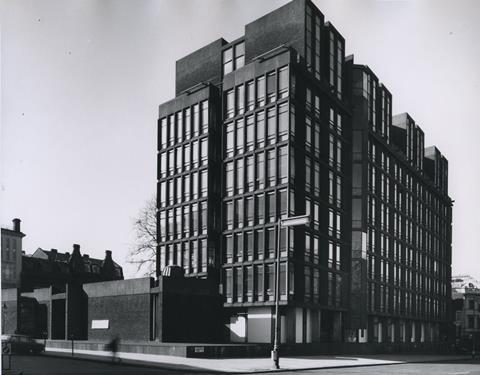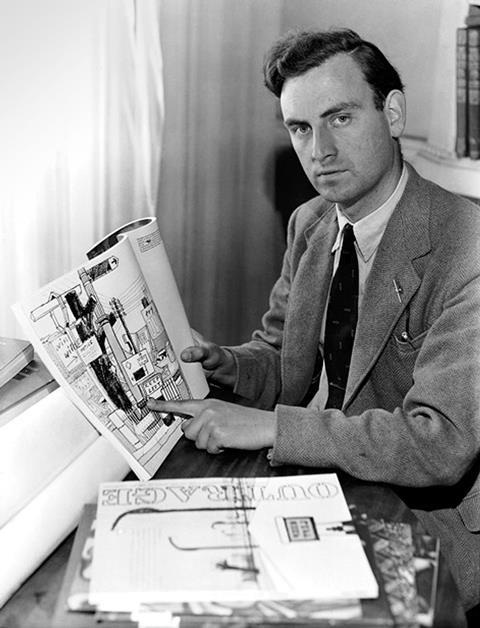Emma Dent Coad welcomes the republication of Nairn’s classic book on modernist London

With so much going on politically, it’s taken me a while to find a suitable space to write this review, having read it just before publication. But on returning to it what I had missed was that this utterly joyful book is an invaluable respite to world news. It is also a perfect antidote to the complete trashing of the Modern Movement by a certain non-architect, and to the very depressing view of our likely next Prime Minister that we can sort out the housing crisis by creating faux-Georgian market towns on grey/green belt, with not a second’s thought to transport or social infrastructure, because he ‘likes Georgian’.
May the gods protect us from law-makers who don’t understand their brief.
Yes, the Modern Movement has taken yet another beating, by someone hugely influential but not especially well informed, who finds it all ‘boring’. And who cannot understand that cities and towns need background buildings as well as shouty, look-at-me and occasionally exciting buildings. What he is proposing it seems, is one after another ‘statement building’ in a kind of architectural Wacky Races.
Exhausting.
So this lovely little gazetteer of MoMo in London is the perfect antidote. Originally written by the very well informed commentator Ian Nairn in 1964, this new edition, with introduction by author Travis Elborough, is a perfectly timed reminder of MoMo’s best bits in London.

I was of course drawn to my own patch in Kensington, and having conducted a few walking tours for Docomomo UK over the years, I was hoping my best buildings were included. Some, of course, had not been built in 1964, and others, sadly, have been gratuitously felled.
Nairn’s descriptive writing is delicious and at times hilarious. His description of Jacob Epstein’s last sculptural work outside the now demolished Bowater House in Knightsbridge is “like an incestuous family fleeing into Hyde Park from the Vice Squad“. Appropriate perhaps, for who knows where the sculpture is now, while One Hyde Park has world notoriety as a depository of allegedly dirty money from international crime.
My personal familiarity and fondness for the Royal College of Art is confirmed here as a building “with a personality as strong as the Albert Hall … yet without self-advertisement. The individuality is internal and shows with affectation in the smallest details …”. I can’t agree with his diagnosis of the Commonwealth Institute as disappointing inside. Perhaps he would prefer the now gutted and refitted version which personally I think diminishes the glorious exterior.

The 100 Notting Hill Gate redevelopment “is no masterpiece but is well worth a visit” according to Nairn. While “stylistically modern [it] is exactly half-way to being true modern architecture”. There is “no longer any worry about a fancy dress for the buildings”, however due to its lack of “human touches” Nairn condemns is as “a failure”. This is a shame as the never-ending story of Newcombe House (which I’ve always admired in its modesty and polite set-back from the thoroughfare) rumbles on, now under consideration yet again from a truly ghastly planning application coming to committee in December.
His joy over the engineered design of Hammersmith Flyover will please numerous fans of this structure, as he praises “the grooving on the underside of the arches, a bit of articulation which comes off splendidly”. Continuing my life-long love of Kensington’s MoMo buildings, Bousfield Primary School was just opposite my own primary school, and I must have been pushed past it in my pram a thousand times before I even started at the Catholic school opposite.
Bousfield fascinated me, with its supermodern form and ‘moat’, and I’m pleased to say it’s listed and still a rather lovely presence among the redbrick mansion blocks of Old Brompton Road. Gratifyingly for me, Nairn calls it “One of the most imaginative new buildings in London, full of ideas and full of humanity too.”
Sadly and despite my own efforts on planning committee to refuse demolition, 24 Hereford Square is feted “For doing a straightforward job exceptionally well, this is one of the best buildings in London”. So much more interesting and charming than the Disneyfied faux Victorian terrace that is supposed to match the rest of the square but does it a huge injustice.
I could go on, suffice it to say that after an extraordinary 60 years, Nairn’s passion for modern buildings in London has barely aged, and is a totally charming and informative narrative that entices you back to enjoy, all over again, your favourite MoMo buildings in London, and possibly to share his thoughts on some of the failures. As he put it “I hope that my comments will leave the reader in no doubt whether I think he is coming on a sheep or a goat”.
Precisely.
>> Also read: Ian Nairn - Words in Place by Gillian Darley and David McKie
Postscript
Modern Buildings in London, by Ian Nairn, first published in 1964, reprinted with an introduction by Travis Elborough by Notting Hill Editions in 2023.
Emma Dent Coad is an architectural historian. She was the Labour MP for Kensington from 2017 to 2019 and has been a councillor in Kensington and Chelsea since 2006. Her book, One Kensington, is published by Quercus.
















3 Readers' comments